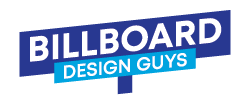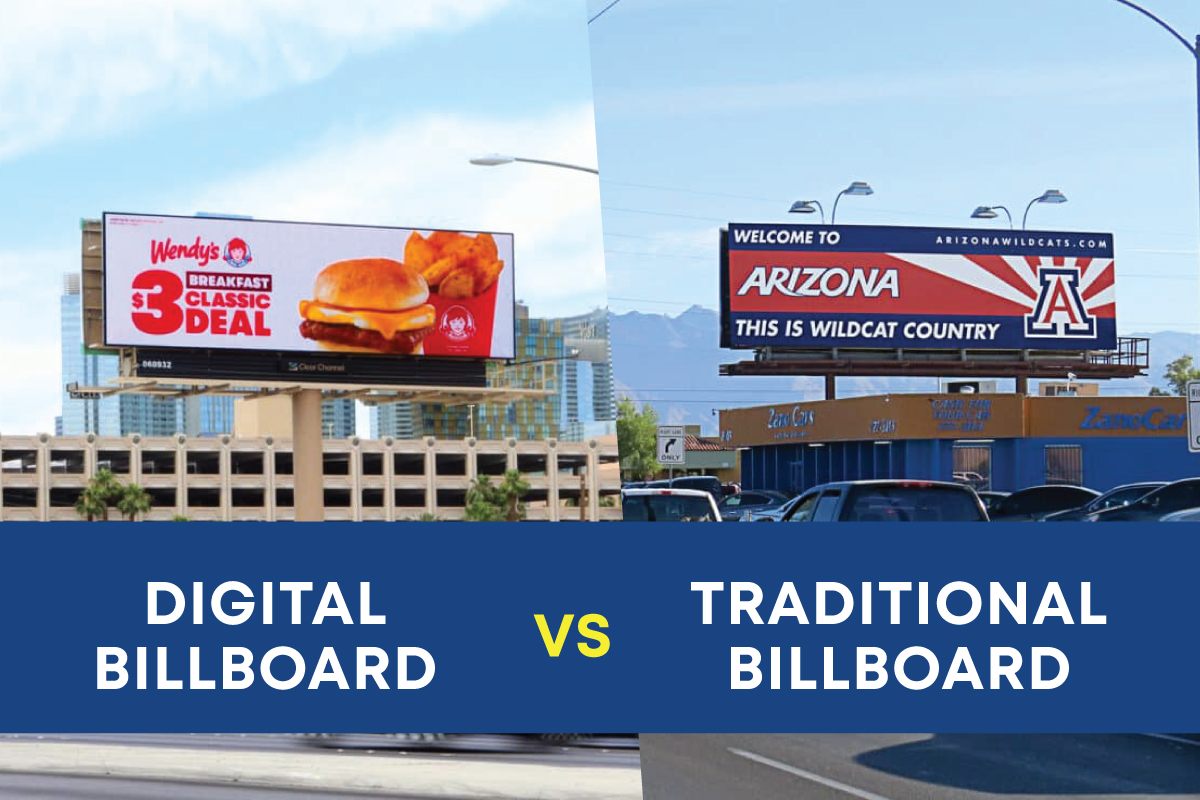In the realm of advertising, billboards have long been a staple for reaching a wide audience and promoting products or services effectively. Over the years, billboards have evolved, with two prominent contenders now competing for attention: Digital billboards and Traditional billboards.
Both formats have their unique advantages and disadvantages, and in this blog post, we will delve into a comprehensive comparison of these advertising giants. By the end, you’ll have a better understanding of which type of billboard might be the best fit for your advertising needs.
1. Definition and Features
Traditional Billboards:
Traditional billboards are the classic, static billboards we’ve seen along highways and city streets for decades. They consist of printed images and text on large vinyl or paper posters, often illuminated by external spotlights. The content remains static until manually replaced.
One of the key benefits of traditional billboards is their simplicity. They are easy to design, produce, and install. Advertisers can work with print companies to create eye-catching visuals that resonate with their target audience.
Traditional billboards have a long history of successfully capturing attention, making them ideal for brand awareness campaigns. The large size and bold imagery demand attention from passersby, leaving a lasting impression.
However, the static nature of traditional billboards limits their flexibility. Content changes require physical replacement, which can be time-consuming and expensive. Time-sensitive promotions or multiple advertisers sharing the same billboard space might find traditional billboards less suitable.
Digital Billboards:
Digital billboards utilize electronic displays to showcase advertising content. These billboards can change their display content dynamically and remotely, allowing for multiple ads to rotate at scheduled intervals.
One of the most significant advantages of digital billboards is their flexibility. Advertisers can remotely update content in real time, enabling adjustments to be made on the fly. Day-parting, where different content is shown during specific times of the day, becomes a possibility.
Location-based targeting is also achievable, tailoring messages to different areas and demographics. The dynamic nature of digital billboards enhances engagement and ensures that the audience remains receptive to new messages.
Moreover, digital billboards can display animated content and even incorporate interactive elements, further increasing their impact. By incorporating technologies like QR codes or NFC tags, advertisers can bridge the gap between the physical and digital worlds, providing a more immersive experience for viewers.
2. Cost and Investment
Traditional Billboards:
Setting up a traditional billboard involves designing and printing the advertisement on a large-scale poster. While the initial cost of printing and installation might be lower than a digital billboard, the ongoing expenses include maintenance, replacement, and manual labor costs for updating content.
The cost of traditional billboards can vary based on factors such as the location, size, and duration of the campaign. Prime locations in densely populated areas or high-traffic highways will generally command higher prices. Additionally, printing a new poster for each content change incurs extra costs, especially for campaigns with frequent updates.
Digital Billboards:
The initial investment for digital billboards is undoubtedly higher due to the purchase of electronic display equipment and the required technological infrastructure. However, once set up, the ability to remotely change content reduces ongoing printing and labor costs, potentially making it more cost-effective in the long run.
Advertisers can design multiple ad creatives for the same digital billboard, allowing for seamless rotations and optimizing exposure. Over time, this can save money compared to traditional billboards where each content change necessitates a new printed poster.
3. Flexibility and Content Management
Traditional Billboards:
Traditional billboards lack flexibility as their static nature restricts content changes to the physical replacement of the poster. This limitation might be a drawback for time-sensitive promotions or multiple advertisers sharing the same billboard space.
The inflexibility of traditional billboards may also lead to decreased relevance if the advertised product or message changes frequently. Advertisers may find it challenging to adapt their campaigns in response to real-time events or changes in their marketing strategy.
Digital Billboards:
Digital billboards excel in flexibility. Advertisers can remotely update content, allowing for real-time adjustments, day-parting, and even location-based targeting. This feature makes digital billboards more adaptable to changing marketing strategies and audience preferences.
For example, during rush hour, a digital billboard near a shopping district might display ads for retail stores, while during late-night hours, it can shift to promoting restaurants and entertainment venues. Additionally, digital billboards can be used for public service announcements or emergency alerts, providing a valuable civic function.
4. Impact and Engagement
Traditional Billboards:
Traditional billboards have a long history of successfully capturing attention. Their large size and eye-catching visuals make them effective for brand awareness campaigns. However, the static nature might lead to diminished engagement over time, especially in high-traffic areas with repeat viewers.
The stationary nature of traditional billboards may result in “ad blindness,” where frequent viewers become desensitized to the message, rendering it less effective over prolonged exposure. The lack of dynamic content can also limit the billboard’s ability to tell a story or convey complex information.
Digital Billboards:
Digital billboards have a distinct advantage when it comes to engagement. The ability to display dynamic, animated content, and even interactive elements can significantly enhance viewer interest and retention. Additionally, the rotation of ads prevents the billboard from becoming stale, keeping the audience engaged and receptive to new messages.
Digital billboards can display multiple creatives within a short span, which can be particularly effective in conveying a sequential narrative or showcasing different aspects of a product or service. This interactivity and variety help maintain the audience’s attention and leave a more lasting impression.
The use of real-time data and dynamic content enables advertisers to incorporate contextual relevance into their ads, fostering a deeper connection with the audience. For example, a restaurant chain could display different ads based on the weather or time of day, promoting warm beverages during colder weather or refreshing drinks on hot days.
5. Environmental Impact
Traditional Billboards:
Traditional billboards are relatively simple and have a lower environmental impact in terms of energy consumption. Once installed, they don’t require a continuous power supply, making them a more eco-friendly option in that regard.
The materials used in traditional billboards, such as vinyl or paper, can be recycled or repurposed after the advertising campaign ends. Additionally, the lack of electronic components means they don’t contribute to e-waste.
Digital Billboards:
Digital billboards demand electricity to power the electronic displays continuously. While advancements in technology have made them more energy-efficient, they still have a higher carbon footprint compared to their traditional counterparts.
Efforts have been made to improve the energy efficiency of digital billboards, such as using LED displays and optimizing power management systems. However, the ongoing electricity consumption remains a factor to consider from an environmental perspective.
6. Regulation and Permits
Traditional Billboards:
Due to their static nature and simplicity, traditional billboards are often subject to less stringent regulations and permit requirements. This can make the process of securing advertising space and setting up the billboard easier and quicker.
In many regions, traditional billboards fall under established zoning and permitting rules. Obtaining the necessary permits involves meeting certain criteria, such as setback requirements, size limitations, and compliance with local aesthetic guidelines.
Digital Billboards:
The electronic nature of digital billboards can lead to more complex regulations and permitting processes. Concerns about distracting drivers or light pollution may lead to stricter rules governing their location and display characteristics.
Some municipalities may have restrictions on the brightness, animation, or frequency of content changes for digital billboards to ensure they don’t cause unnecessary distractions for motorists. Additionally, there may be limits on the locations where digital billboards can be installed to preserve the visual character of the area.
Conclusion
In the ever-evolving world of advertising, the battle between Digital Billboards and Traditional Billboards offers a diverse array of options for businesses seeking to make a significant impact. While traditional billboards have a long-standing legacy in capturing attention and fostering brand awareness, digital billboards take the stage with their flexibility, interactivity, and dynamic content capabilities.
At Billboard Design Guys, we understand the importance of creating impactful advertising campaigns that leave a lasting impression on your target audience. Our team of skilled designers and marketing experts is dedicated to helping you choose the perfect billboard format that aligns with your unique marketing goals and budget.
For those seeking cost-effective, static visuals with broad reach, traditional billboards can be a reliable choice. We specialize in crafting captivating designs that demand attention and effectively convey your message to a diverse audience.
If you’re looking to stay ahead of the curve and embrace the future of advertising, digital billboards present an exciting opportunity to engage your audience like never before. Our expertise in creating dynamic, eye-catching digital content ensures your brand will shine brightly and captivate viewers’ attention in the bustling world of digital advertising.
No matter which billboard format you choose, our team is here to guide you through the entire process, from creating a concept to making it live, ensuring your advertising campaign achieves maximum impact and drives measurable results. With our dedication to creativity, innovation, and environmental consciousness, we aim to deliver an advertising solution that not only boosts your business but also contributes to a greener planet.
Partner with Billboard Design Guys and unlock the potential of billboard advertising to reach your target audience effectively and elevate your brand to new heights. Contact us today to explore how we can collaborate to create an advertising campaign that stands out in the crowded marketplace and propels your business toward success.
Let’s illuminate the world together with stunning billboard designs that leave a lasting impression on everyone who passes by.

